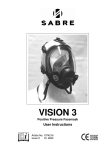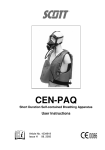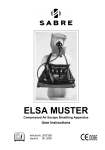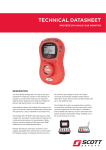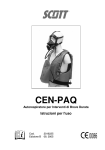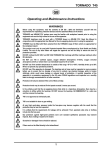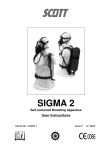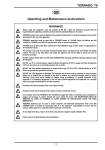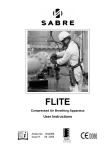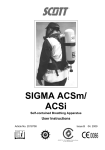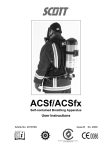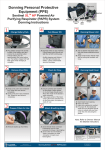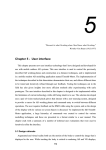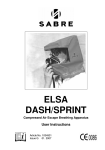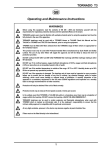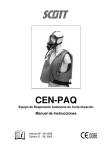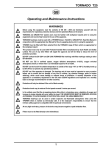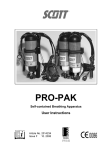Download Panaseal User Manual in English
Transcript
PANASEAL Positive Pressure Facemask User Instructions Article No. 2015585 Issue A 10. 2004 PANASEAL Positive Pressure Facemask Contents WARNINGS ............................................................................................................................... ii 1. INTRODUCTION ............................................................................................................ 1 1.1 BREATHABLE AIR .................................................................................................. 1 1.2 COMPRESSED AIR AIRLINE SUPPLIES ............................................................... 1 1.3 APPARATUS DURATION ....................................................................................... 2 1.4 PERSONNEL TRAINING ........................................................................................ 2 1.5 SERVICING ............................................................................................................. 2 1.6 SPARE PARTS AND ACCESSORIES .................................................................... 2 1.7 NOTIFIED BODIES ................................................................................................. 2 2. APPARATUS DESCRIPTION ........................................................................................ 3 2.1 GENERAL ............................................................................................................... 3 3. PRE-USE AND MONTHLY CHECKS ............................................................................ 3 3.1 CHECKS.................................................................................................................. 3 3.2 PRE-USE TESTS .................................................................................................... 3 3.3 POSITIVE PRESSURE TEST ................................................................................. 5 3.4 BREATHING APPARATUS’ TESTS ........................................................................ 5 4. DON APPARATUS ......................................................................................................... 5 4.1 ATTACH DEMAND VALVE ..................................................................................... 5 4.2 DON FACEMASK .................................................................................................... 5 4.2.1 Web Headharness............................................................................................ 5 4.2.2 Net Headharness ............................................................................................. 6 4.2.3 All Versions ...................................................................................................... 6 4.3 POSITIVE PRESSURE TEST ................................................................................. 6 4.4 FACEMASK SEAL TEST ......................................................................................... 7 4.5 BYPASS TEST ........................................................................................................ 7 5. DOFFING THE APPARATUS ........................................................................................ 7 6. AFTER USE ................................................................................................................... 8 6.1 CLEANING .............................................................................................................. 8 6.2 RECORD TEST DETAILS ....................................................................................... 8 6.3 STORAGE ............................................................................................................... 8 7. SCHEDULED MAINTENANCE ...................................................................................... 9 7.1 MONTHLY ............................................................................................................... 9 7.2 ANNUALLY.............................................................................................................. 9 Sabre Breathing Apparatus is a division of Scott Health and Safety Limited. Registered Office: Scott Health and Safety Limited, Pimbo Road, West Pimbo, Skelmersdale, Lancashire, WN8 9RA, United Kingdom. i WARNINGS Please Read Carefully and Fully Understand This manual is for use by personnel trained in the use and care of compressed air breathing apparatus, and MUST NOT be used as a self-teaching guide by untrained users. Failure to understand or adhere to the PanaSeal user instructions may result in injury or death. Scott Health and Safety Limited have taken great care to ensure that the information in this manual is accurate, complete and clear. However, Training & Technical Support Services will be pleased to clarify any points in the manual and answer questions on Sabre breathing apparatus. The following warnings are in accordance with certifying authority requirements and apply to the use of breathing apparatus in general: Breathing apparatus users must be fully trained in the use and care of selfcontained, compressed air breathing apparatus. Ensure that the selection of the apparatus type is sufficient for the tasks being undertaken and the hazards likely to be encountered. Please refer to National Regulations for guidance. Adequate protection may not be provided in certain highly toxic atmospheres. The apparatus must be tested and serviced in accordance with Section 7 Scheduled Maintenance and the notes in Section 1 under Training & Servicing. The quality of air used to supply and charge breathing apparatus must meet the requirements of EN 12021 : 1995. See Section 1 for details. Ensure that a good seal can be obtained between the face and facemask. The wearing of beards, side-burns or spectacles may adversely affect the sealing of a facemask to the wearer's face. The apparatus is not designed for use underwater. The harness must not be used as a vehicle seat restraint Ensure that you are familiar with the Warnings, Cautions and Limitations contained in the user instructions for apparatus to be used with PanaSeal. PanaSeal will only provide the Class 3 respiratory protection described in EN 136 : 1998 when used with an apparatus for which it is approved. DISCLAIMER Failure to comply with these instructions or misuse of the apparatus may result in: death, injury or material damage, and invalidate any warranty or insurance claims. COPYRIGHT This manual must not be copied in part or whole, or used for purposes other than its intended purpose without the written permission of Scott Health and Safety Limited. ii PANASEAL 1.2 1. INTRODUCTION 1.1 BREATHABLE AIR Air for use with compressed air airlines must conform to prEN 12021 : 1995 and must have a dew point sufficiently low to prevent internal freezing when apparatus is used in temperatures below 4°C. Air used to supply or charge breathing air may be natural or synthetic. The composition of breathable air is given in Table 1. COMPONENT MASS % (Dry Air) COMPRESSED AIR AIRLINE SUPPLIES VOLUME% (Dry Air) No. of Wearers Airflow (L/min.) 1 300 2 450 OXYGEN 23.14 20.948 NITROGEN 75.52 78.08 3 750 ARGON 1.29 0.93 4 900 CARBON DIOXIDE 0.05 0.031 4 Table 2 Airline pressure must be between 5.0 9.0 bar (70 - 130psi). Airflow supply capacity for a single airline is given in Table 2. HYDROGEN 0.000 003 0.000 05 NEON 0.001 270 0.001 818 HELIUM 0.000 037 0.000 524 KRYPTON 0.000 330 0.000 114 XENON 0.000 039 0.000 009 Generally - One wearer requires 300 L/min. Each additional wearer requires 150 litres/minute, each additional pair of wearers requires 450 L/min. All measurements must be taken at the wearer end of the airline. Table 1: Breathable Air There is an increased fire risk when the oxygen content is above the value shown above. Example: for 8 users (4 pairs) the recommended flow is 4 x (300 + 150) = 1800 litres/minute. The purity/quality of air used to supply and charge breathing apparatus should be tested periodically in accordance with national regulations. If not specified otherwise, contaminants shall not exceed permissible exposure level. A Sabre airline flow tester is available from Scott Health and Safety Limited under Article Number 1035978. the the Compressed air airlines must be Sabre products, approved to EN 139. Ensure that hoses used in an explosive or inflammable atmosphere are marked: ANTI-STATIC – EN 139. National regulations must be observed. The mineral oil content shall be such that the air is without the odour of oil. The odour threshold is in the region of 0.3 3 mg/m . Cost effective PVC hoses may be used in other atmospheres. Scott Health and Safety Limited manufacture a range of anti-static and PVC hoses, in lengths ranging from 15m to 60m. Our Customer Services Department will be pleased to advise on price and delivery. The water content shall not exceed 50 3 mg/m for 200 bar apparatus and 30 3 mg/m for 300 bar apparatus. For airline apparatus, air must be used with a dew-point sufficiently low to prevent internal freezing. 1 PANASEAL 1.3 APPARATUS DURATION 1.5 All durations quoted are nominal, based on an Average Wearer Consumption Rate of 40 litres/minute and FULLY CHARGED cylinders. Actual Wearer Consumption rates vary due to many factors, such as: 1. Workload: high work rates increase consumption rates. 2. Weight of apparatus and use of heavy or restrictive clothing. 3. Work environments with extremes of heat or cold. 4. Physical fitness of the wearer. 5. Other factors include emotional stress and fatigue. 6. Supplying cylinder air to a resuscitator or rescue second mask (RSM). Your Sabre distributor or Training & Technical Support Services will be pleased to provide training course details and quotes for service contracts. Please see above for contact details. 1.6 SPARE PARTS AND ACCESSORIES Customer Services provide an efficient, friendly, customer contact point for ordering new apparatus, spare parts and accessories. The team can also provide general information on Sabre products. Customer Services: Scott Health and Safety Limited Pimbo Road, West Pimbo, Skelmersdale, Lancashire, WN8 9RA, United Kingdom. It is important that all wearers are aware of these factors and take account of them when assessing cylinder duration. 1.4 SERVICING PanaSeal must be serviced at scheduled intervals by personnel who have completed a formal training course and hold a current certificate for the servicing and repair of Sabre breathing apparatus. Details of the servicing schedule are contained in the appropriate Service Manual, copies of which can only be obtained by registered holders of a current certificate. PERSONNEL TRAINING Personnel who use self-contained, compressed air breathing apparatus must be fully trained in accordance with these instructions and national regulations. These instructions cannot replace an accredited training course run by fully qualified instructors in the proper and safe use of Sabre breathing apparatus. Tel: +44 (0) 1695 711711 Fax: +44 (0) 1695 711775 Please contact Training & Technical Support Services or your Sabre distributor for training course details. Training & Technical Support Services: Scott Health and Safety Limited Pimbo Road, West Pimbo, Skelmersdale, Lancashire, WN8 9RA, United Kingdom. 1.7 NOTIFIED BODIES Inspec International Ltd (No. 0194) Upper Wingbury Courtyard, Wingrave, Aylesbury, Buckinghamshire, HP22 4LW, United Kingdom. British Standards Institute (No. 0086) 389 Chiswick High Road, London, W4 4AL, United Kingdom. Tel: +44 (0) 1695 711711 Fax: +44 (0) 1695 711775 2 PANASEAL 2. APPARATUS DESCRIPTION 3. PRE-USE AND MONTHLY CHECKS 2.1 3.1 GENERAL CHECKS 1. Check that the facemask is clean and undamaged. PanaSeal is a Class 3 positive pressure full face mask for use with Breathing Apparatus (BA) used by fire-fighters and other applications where a high level of respiratory protection is required. It is approved for use with all Sabre self contained breathing apparatus approved to EN 137, and compressed air airline breathing apparatus approved to EN 139. 2. Check that the visor is free from blemishes that might impair vision. 3. Check that the headharness/head net is complete and in good condition; and that the straps are fully slackened. It is approved to EN 136 : 1998 CL 3 and is CE marked in accordance with EEC Directive EC/686/1986. PanaSeal is moulded in non-dermatitic black Neoprene or blue Silicone. The polycarbonate visor conforms to EN 166 Grade B for impact resistance. It is available with a five-point, fully adjustable web or net headharness. Both versions have a neck-strap. An inner mask, with a speech diaphragm, minimises CO2 dead space and visor misting. 4. On the apparatus intended for use, check that the orange O-ring on the DV outlet is clean and in good condition. 3.2 PRE-USE TESTS 1. Fit the DV of a breathing or airline apparatus, for which PanaSeal is approved, to the facemask. Versions of the mask are available for use with the Gallet F1TM helmet. Note: If PanaSeal is to be used with RAS, fit filter and filter cover after first ensuring that the filter and filter O-ring are clean and in good condition. 3 PANASEAL 2. Check that the red locking catch engages fully. Twist the DV gently to confirm that it has. 3. Open the air supply valve fully. 6. Facemasks with a net harness: Hold the mask by the side of the net harness, place the chin into the chin-cup and pull the mask onto the face. Grasp the pull-strap at the rear of the net harness and pull the net over the head. 4. Facemasks with a web harness: Hold the headharness lower straps, place chin in chin-cup and pull straps over back of head, brushing back hair from under faceseal. 7. Facemasks with a net harness: Tighten harness side straps. DO NOT over-tighten. 8. All Facemasks: Inhale deeply and check that the DV first breath mechanism operates. 5. Facemasks with a web harness: Tighten harness straps in sequence, Bottom, Middle, Top. DO NOT overtighten. 4 PANASEAL 3.3 POSITIVE PRESSURE TEST 4. DON APPARATUS 4.1 ATTACH DEMAND VALVE 1. Check that the PanaSeal headharness is fully slackened and that the DV is connected to the facemask. 2. Place the neck-strap round the neck. 1. With the cylinder valve open, insert a finger under faceseal and check for a steady outward flow of air. Remove finger and allow mask to re-seal. 3. Check that the flat on the DV bypass knob is off (Flat on the knob is towards the facemask). 2. Hold breath for ten seconds and listen for leaks. If there are leaks, loosen the headharness and adjust the mask for a comfortable leak-tight fit and repeat test. DO NOT over-tighten the headharness. 4. 5. Follow the appropriate breathing apparatus’ user instructions to supply air to the facemask. 3. DO NOT USE apparatus that leaks. Attach an explanatory note and return for servicing. 3.4 Press the black reset button. 4.2 BREATHING APPARATUS’ TESTS 4.2.1 1. Perform any tests detailed in the appropriate breathing apparatus’ user instructions. 5 DON FACEMASK Web Headharness PANASEAL 1. Hold the headharness lower straps, place chin in chin-cup and pull straps over back of head, brushing hair away from faceseal. 2. Tighten harness side straps. DO NOT over-tighten. 2. Adjust the facemask top strap so that the mask is at the correct level with the face and the headharness pad is in the centre of the back of the head, then tighten harness straps in sequence: Bottom, Middle, Top. DO NOT overtighten. 4.2.2 4.2.3 All Versions 1. Inhale deeply to activate the DV, then breathe normally. 4.3 POSITIVE PRESSURE TEST Net Headharness 1. With the cylinder valve open, insert a finger under faceseal and check for a steady outward flow of air. Remove finger and allow mask to re-seal. 1. Hold the mask by the side of the net harness, place the chin into the chincup and pull the mask onto the face. Grasp the pull-strap at the rear of the net harness and pull the net over the head. 6 PANASEAL 4.4 FACEMASK SEAL TEST 5. DOFFING THE APPARATUS 1. Close the cylinder valve and keep hold of the handwheel. Hold breath for 10 seconds and listen carefully for leaks. A leak will cause the pressure gauge reading to fall. WARNING: DO NOT remove apparatus until well clear of the hazardous area. 2. If the facemask fails the leak test: open the cylinder valve, loosen the headharness, adjust the facemask and repeat the test. 4.5 BYPASS TEST 1. Hold breath and press the DV reset button. 1. Turn on the DV bypass knob and check for a steady flow of air into the mask, then close the bypass. 2. Release the head harness by pulling the harness buckles forwards. Remove mask and let it hang from the neck-strap. 3. Close the air supply valve and follow the After Use instructions for the air supply apparatus. 4. Clean and test described in Section 6. 7 PanaSeal as PANASEAL TriGeneTM disinfecting wipes are available from Scott Health and Safety Limited under Article Number 2004225 (pack of 20). 6. AFTER USE 6.1 CLEANING Cautions: • USE ONLY the specified methods and materials. DO NOT use bleach, solvent, detergent or abrasive cleaners. • Dry thoroughly, away from direct heat and sunlight, prior to storage. 6.2 RECORD TEST DETAILS Record test details, in accordance with local regulations, within a Breathing Apparatus Logbook (available from Scott Health and Safety Limited under Article Number 1034745). 6.3 STORAGE The apparatus must be stored in a clean, dry environment away from direct heat and sunlight. Storage temperature should not exceed +40°C to -10°C. 1. Disconnect DV from the facemask. 2. Wash and disinfect the mask thoroughly in a solution of TriGene TM and warm water. See following Note. 3. Rinse the mask thoroughly in clean running water. Pay particular attention to flushing out the exhale valve. 4. Hang mask by it’s neckstrap and allow it to dry thoroughly away from direct heat or sunlight. 5. When dry, wipe facemask seals with TriGene TM disinfectant wipes. 6. Polish the visor inside and out with a clean, lint-free cloth and slacken the head harness, ready for use. Note: TriGene TM is available from Scott Health and Safety Limited in 1 litre and 5 litre containers under Article Numbers 2008247 and 2008248 respectively. Pump dispensers are available for the above under Article Numbers 1017672 (1 litre) and 1017670 (5 litres). 8 PANASEAL 7.2 7. SCHEDULED MAINTENANCE 7.1 ANNUALLY PanaSeal must be returned for a workshop service annually and for a major workshop service at six-yearly intervals. MONTHLY Test PanaSeal in accordance with Section 3 - Pre-Use and Monthly Checks. After each workshop service, perform the user checks detailed in Section 3 – PreUse and Monthly Checks prior to returning PanaSeal to service. Record test details in the apparatus’ BA Logbook. This record is mandatory in the UK and most EC countries, and must be kept up to date and available for inspection. Check that workshop service details have been recorded in the apparatus’ BA Logbook. Please see Section 6.2 for details. 9 Sabre Breathing Apparatus Scott Health and Safety Limited Pimbo Road, West Pimbo, Skelmersdale, Lancashire, WN8 9RA, United Kingdom. Tel: +44 (0) 1695 711711 Fax: +44 (0) 1695 711775













